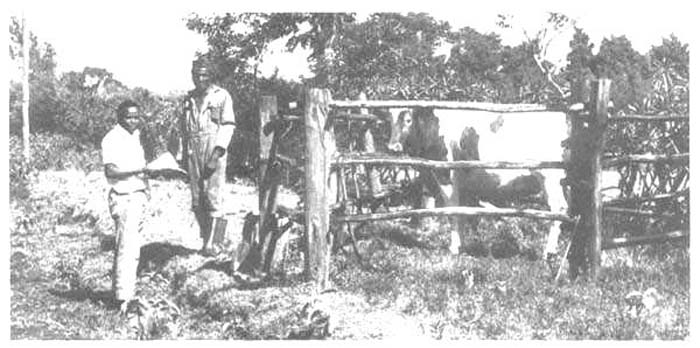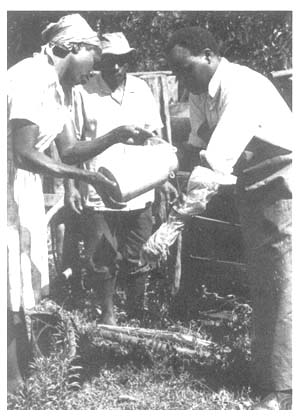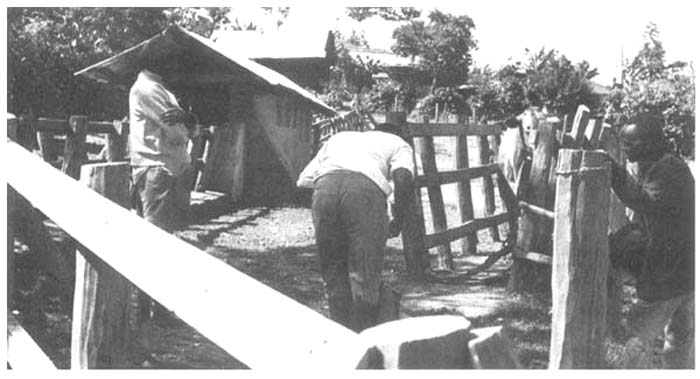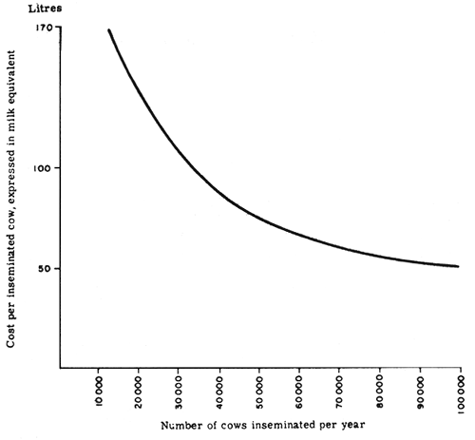A. Bane and C.A. Hultnäs
The improvement of livestock production which has been so remarkable in many industrialized countries, particularly in the last two decades, is due to the intergrated effect of rapid developments in several fields of the industry. Increased feed production, improved animal health, better husbandry, and the breeding of animals with the necessary genetic potential for improved performance are the most important of these developments. In developing countries, however, parallel improvements in livestock production have generally been inadequate, and one of the principal limiting factors has been the lack of genetically improved animals.
There are different ways of increasing the numbers of genetically improved animals. Selection within existing local populations may be practised, but this method often has to be ruled out because of the low genetic base with which one has to start. The importation of superior breeding stock is too costly to be adopted on a large scale. Problems of adaptability also arise when high-yielding cattle are transferred from temperate to tropical and subtropical environments. Crossing local females with superior imported sires is another method adopted at different periods by many developing countries. With the advent of artificial insemination (A.I.), the principle of crossbreeding was given a new instrument for implementation on a large scale and at comparatively low cost.
A. Bane is professor at the Royal Veterinary College, Stockholm., Sweden; C.A. Hultnäs is with External Consultancy Projects, Association for Swedish Livestock Breeding and Production, Hällsta, Sweden.
Artificial insemination in developing countries
In spite of the efforts made to introduce large-scale A.I. breeding services in several developing countries, growth in the use of A.I. has generally not been very strong, although there have been notable exceptions. Reviews of the development of A.I. are hampered by the scarcity of statistics on the extent to which it is used and of information on the technical results of A.I. services in individual countries. However, some estimates of the global application of A.I. give an idea of its use in developing countries.
Based on a survey of the situation in 1961 and 1962 by Nishikawa (1964) it was estimated that approximately 59 million cattle in the world were being artificially inseminated at that time. Of this world total, some 56 million were in Europe, North America, Oceania and Japan, leaving only about 3 million artificially inseminated cattle in the rest of the world.
In a recent world survey, Bonadonna (1972) received information from 52 countries, and these reported that more than 88 million cattle had been subjected to A.I. in 1970. Of these, Europe (including the U.S.S.R.), the United States, Canada, New Zealand, Australia and Japan accounted for 73 million and the rest of the world for about 15 million. Bonadonna pointed out that his survey was incomplete and that there were several countries from which no information had been received. He estimated the total number of artificially inseminated cattle and buffaloes in the world to be more than 120 million a year.
Bonadonna's figures suggest that roughly 10 percent of the world's population of cattle and buffaloes were being subjected to artificial insemination by the end of the 1960s. However, there is great variation in the incidence of inseminated animals both between and within geographic regions. On the basis of the total populations of cattle and buffaloes, it may be estimated that about 30 percent are artificially inseminated in Europe, North America, Australia, New Zealand and Japan, while the corresponding figure for the rest of the world is around 4 percent. Only in a few developing countries does the incidence of cows served by A.I. exceed 1 percent of the total cow population. Notable exceptions are Cuba, where about 1.5 million cows (representing 50 percent of the country's dairy cows) are served, and Kenya, where about 500 000 inseminations are recorded annually.
Principal factors to be considered
Artificial insemination is a comparatively sophisticated method of animal husbandry. Its impact on cattle development is closely linked to the simultaneous introduction of reasonable standards of animal nutrition, disease control and husbandry, and of infrastructure. Unfortunately this has not always been recognized, and in some cases A.I. has been adopted purely as a technical method of getting cows in calf. The aim of cattle improvement — increased and more economical cattle production — has usually failed in such cases. It is therefore necessary to emphasize that any A.I. scheme aimed at largescale improvement of the national herd must be supported by programmes for the improvement of the closely allied sectors of animal husbandry and animal health.
It should be recognized in this connexion that A.I. techniques and organization used in the industrialized countries do not necessarily apply to developing countries. There are several constraining factors specific to these countries which call for specific solutions.
Incentives for farmers
In developed countries the largescale application of A.I. has played a key role in livestock improvement, particularly in respect of dairy cattle. This was largely due to the promise of economic advantage that the technique had to offer.
It would thus be reasonable to assume that a basic precondition for the successful introduction or extension of A.I. services in developing countries would be the provision of economic incentives to farmers to breed improved animals. Areas for the operation of A.I. breeding services should therefore be selected in relation to such considerations as market prospects, feed availability and animal health conditions. Where dairy cattle are concerned, preference should be given to areas with an organized milk collection scheme and a satisfactory outlet for milk and milk products.
There are also certain basic technical qualities required of an A.I. service. Once an A.I. scheme is introduced it should be available at all times, and not be allowed to collapse because of inadequate resources or because of conflicts among representatives of the component disciplines of genetics, veterinary science, animal husbandry and economics, whose close cooperation is essential for the programme. It is also important to ensure that the service is reliable and that it results in acceptable conception rates. The introduction of A.I. by over-enthusiastic individuals who underestimate the resource requirements of such a service can do more harm than good, because once the farmers lose their confidence in A.I., which is inevitable in such circumstances, it is difficult to regain it.
Staffing an A.I.service
The execution of an A.I. breeding service requires specialized staff at various levels. The importance of well-trained inseminators is sometimes overlooked. The success of an A.I. scheme is dependent on its reliability and on its technical results, which are to a large extent governed by the link that the service has with the farmers, namely, the inseminators. Inseminators must therefore be well trained and must undertake their job as a full-time responsibility. Sometimes A.I. is performed by an animal health assistant as part of his duties; experience with this kind of dual-purpose technician has demonstrated the unreliability of the resulting service.

The best way of producing efficient inseminators is to select young men or women with agricultural backgrounds at the time they leave school, and give them a course in general animal husbandry followed by a specialized course in A.I. techniques. During the first months of practical work, supervision should be exercised by a senior inseminator and the work should be carried out by the trainees on a full-time basis. It should be borne in mind that some people will never become good inseminators because they do not have the necessary practical talent, and therefore in the training of inseminators provision should be made for drop-outs.
An A.I. technician stops at a road-side crush. Note the herd record file brought with the cow for recording the insemination. Crushes are simple wooden constructions erected along established routes for A.I. operations. This system has been practised extensively in east Africa at a service to smallholdings.

Good hygienic standards are necessary in A.I. work. Here, the owner of the cow has provided soap, water and a towel for the technician.
Another important consideration in ensuring good performance by an inseminator is motivation. The A.I. recording scheme should make possible the evaluation of individual inseminators, so that motivation may be provided in the form of a suitable monetary award for good performance.
Organization of field services
In addition to reliability and good technical results, the successful extension of an A.I. breeding service is dependent on its ready availability to farmers. The pattern developed in industrialized countries, where a central office receives orders by telephone for insemination and inseminators move from one farm to another by car, is usually not applicable in developing countries. Different systems have been evolved to resolve local difficulties.
In Asia, extensive use is made of A.I. subcentres, to which farmers bring their cows in heat. This system works well in densely populated areas, and has the advantage of enabling groups of farmers to be brought together for demonstrations of milking techniques, feeding and care of newborn calves, and so on, by other extension personnel. Audiovisual aids have been found to be extremely valuable in these demonstrations.
The drawback of this system, however, is that it does not bring the technical staff into direct contact with the problems of the farms.
An extension of this system is the use of road-side crushes, which are simple wooden constructions erected along a given route, for A.I. operations. This method has been practised extensively in east Africa as a service to smallholdings. The roadside crushes are visited by the inseminator according to a fixed schedule. Transport from one crush to another may be by bicycle, motorcycle or car, depending on the density of the cattle population and on road conditions. With motorized transport this system works efficiently, enabling inseminators to perform 10–20 inseminations per day, and the farmers themselves do not need to walk their cattle more than about 3 kilometres each way. In a variation of this system, the inseminators check regularly at certain points where farmers can place a call for a visit; the inseminators then go to the farm to perform the insemination.
In Kenya, A.I. crushes are sometimes used also for the provision of routine field veterinary services. This system offers the advantage that some of the services essential for the development of livestock production can be made available at the same location; it should be tested further, and applied in countries with relatively low cattle densities and reasonably good road communications.
The artificial insemination of cattle on the range has met with special problems. However, promising systems have been developed to overcome these problems, using A.I. camps. Animals suitable for A.I., such as cows with calves at foot, are selected from the herds and moved to the camp, which is essentially an area that has been fenced to exclude bulls. The cows are kept at the camps for about three months, during which period they are observed for symptoms of heat, inseminated, and then examined for pregnancy. At the time of introduction to the camp the animals are given extra feed if necessary, supplemented with minerals and vitamins to stimulate their reproductive functions and to overcome any periods of anoestrus, and where indicated they are also treated for infertility.
Schemes of this type have been successfully adopted with beef cattle in some African countries as a means of introducing improved genetic material into indigenous cattle populations.
Heat detection
Heat detection has been reported to be one of the major management problems in developing countries in connexion with A.I. (Dassanayake et al., 1961; Settergren, 1969). Zebu cattle show less intensive symptoms of heat and remain in oestrus for a shorter period than temperate breeds (Anderson, 1944). Also, high environmental temperature has a direct effect on the reproductive functions of both temperate and tropical cattle. Gangwar et al. (1965) found a higher incidence of clinical anoestrus among Holstein heifers under hot controlled climatic conditions; the oestrous cycle was prolonged but duration and intensity of oestrus were decreased. Other experiments in the United States (Bond and McDowell, 1972) have also indicated that severe heat stress will cause true anoestrus, but that beef heifers can become acclimatized and reestablish their oestrous cycles.

In Kenya, A.I. crushes are sometimes used also for field veterinary services. This crush is combined with a cattle dip.
It is not easy to assess to what extent the difficulty in oestrus detection in the tropics, in connexion with A.I., is due to lack of heat symptoms. With intensive 24-hour visual observation and other methods of heat detection in a large herd of mainly Friesian cattle at pasture in Australia, Williamson et al. (1972) found that out of 107 cows, 96 exhibited standing oestrus within 24 days of the commencement of the trial.
Prior to the study it was believed that a serious problem of anoestrus or suboestrus existed in the herd. However, the investigations revealed that a maximum of about 4 percent of the cows were in true anoestrus not connected with clinically detectable abnormalities of the genital tract. The low level of true anoestrus in this study suggests that if oestrus detection is improved the apparent anoestrus problem may disappear.
In a study of three central African cattle breeds in Zambia, kept under continuous 24-hour observation and checked by a vasectomized teaser bull, Rakha et al. (1970) found the length of the oestrous cycle to be similar to that of temperate breeds. The duration of oestrus and the time of ovulation were also similar to those of temperate breeds, being 16.26 ± 1.08 hours in Angoni, 17.43 ± 1.18 in Barotse and 14.79 ± 3.03 in Boran cattle. The psychic signs of heat were detectable in animals that showed standing oestrus, although the intensity was much less than in breeds in temperate regions.
Certainly, problems in recording oestrus depend to a great extent on the interaction between the accuracy of the procedures for heat detection and the intensity of oestrus symptoms shown by the animals. Increased frequency of oestrus observation increases the number of heat periods detected. It is interesting to note in this connexion that Rakha et al. observed a bimodal distribution of the onset of oestrus in the central African breeds: one maximum occurred around sunrise and another around sunset. From this and other studies (Hall et al., 1959) it appears that in addition to the usual practice of observing heat in the mornings and during the day, it would be of advantage to include observations very early in the morning and late at night. However, practical experience indicates that the signs of heat in tropical cattle are obvious enough to be detected with ease, and that the time interval between onset of heat and ovulation is long enough to provide for satisfactory conception rates even if the A.I. service is available only once every 24 hours. What is important is the necessary motivation on the part of farmers to detect heat.
Most reports suggest that the detection of oestrus is markedly facilitated by the use of teaser bulls. But this method has certain limitations. If vasectomized bulls are used the risk of spreading venereal disease is present, and the method should therefore be precluded from areas where vibriosis and trichomoniasis are known to exist. The use of bulls with surgically deviated penes is safer. but such bulls perform their task for only a limited period and must then be replaced.
Recording
An efficient information system is a necessary component of an A.I. breeding service. First, the actual conception rates per bull, per inseminator and per area would need to be recorded. Complete information on the number and performance of inseminated animals in various areas is also essential. It has been frequently observed that while the detailed primary data on A.I. may be well recorded, they are seldom processed and made use of in the future planning and implementation of the service. There is a real danger that the primary collection of data can be made so ambitious that the processing becomes too difficult. It is therefore important to limit records to those which are really necessary, and to establish a system for the regular processing of up-to-date information from the operations.
Supply of semen
The long-term preservation of semen by deep-freezing allows considerable flexibility in arrangements for the supply of semen. In the initial phase of an A.I. programme, the semen can often be imported and domestic semen production postponed to a later phase. Another important implication of the use of frozen semen is that the semen production unit can be geographically independent of the actual A.I. field work. Freezing also permits a more efficient use of the semen; 10 000 to 20 000 doses can be utilized per A.I. bull per year, whereas if the semen is used in liquid form the actual number of doses used is reduced to around 5 000.
Whether semen should be produced domestically or imported should be determined in the context of both the breeding programme and the costs involved. Thus, where the breeding policy dictates that exotic blood should be maintained at somewhere between 50 and 75 percent in the breeding animals it may be necessary to produce semen from domestic crossbred bulls, and this would call for the establishment of a national semen production unit at the time when the F1 and/or the first backcross generations are ready for insemination. Similarly, when the number of semen doses is of the order of hundreds of thousands per year, it may be economically justified to produce the semen locally even if the bulls have to be imported. There may also be instances where domestic production may have to be supplemented by the importation of semen from, say, progeny-tested bulls.
Costs
The costs of an A.I. breeding service vary widely among countries, and depend mainly on cattle density and the number of cows served. In the initial stages, with a small number of animals being inseminated, the cost per cow is high. The graph (opposite) shows the approximate relation between the variable costs per inseminated cow and the total number of animals served. The costs are expressed in litres of milk at producer prices, and are derived from planning documents for comprehensive A.I. services in Tanzania and Pakistan, prepared in collaboration with the governments of these countries, and from actual costs in Kenya.
In industrialized countries A.I. costs per cow vary between the equivalent of 40 and 75 litres of milk, depending on cattle density, the intensity of selection of sires, the costs of progeny testing and other evaluation activities. The major expenses of an A.I. breeding service are represented by the wages of the personnel, which in many instances amount to over 80 percent of the total variable costs. The foreign currency cost in developing countries is relatively small, compared with the alternative costs of acquiring a corresponding number of genetically improved cows, or bulls for natural service. However, in the initial stages of an A.I. scheme, as it would not be possible for the farmer to pay a fee corresponding to the full cost of the service, a government subsidy is usually provided.
A smallholder's herd of crossbred cattle, all got by artificial insemination.

Relation between variable costs per inseminated cow and total number of animal served, expressed in litres of milk at producer prices.

The International Bull Semen Donation Scheme
Recognizing that A.I., even on a limited scale, could assist developing countries in their plans for cattle breeding, and that frozen semen offers excellent opportunities for the transfer of genetic material of high production potential for building up nucleus herds of improved cattle, FAO has organized an international scheme for donations of frozen bull semen.
A.I. breeding services in many developed countries entail the collection and deep-freezing of considerable quantities of semen, but not all this high-quality genetic material is required for field use, and much of it could be used for the improvement of indigenous cattle in developing countries. A number of countries have agreed to participate in this scheme and donate semen to interested developing countries. Due to shipping and other requirements the scheme applies only to frozen bull semen stored in liquid nitrogen.
The basic idea behind the scheme is to build up nuclei of foundation stock of first-class animals. The nucleus herd, which may be located at a government farm or cooperative, or at an existing A.I. station, will produce bulls for use within the recipient country. Multiplication from the nucleus herd may be by means of upgrading, or by the use of crossbred bulls for natural service or, when feasible, by A.I. In some cases the donated semen may be used for crossbreeding activities on a field scale.
Certain conditions are important for satisfactory results in the recipient countries. Liquid nitrogen and containers for the storage of the frozen semen must be available and personnel must be trained in the use of frozen semen. However, the high costs of establishing and maintaining a bull centre and of importing bulls can be avoided in the initial stage of the A.I. programme. FAO maintains close liaison between recipients and donors, and assists in developing realistic projects under the scheme. The commitments of the donor and the recipient country are regulated in a Letter of Understanding, and each project will last three to five years. Initially the scheme has been concerned with recipient countries in Asia. Preparatory studies of the feasibility of semen donations to a number of countries in Africa have also been undertaken and will be followed by similar studies of countries in Latin America.
References
Anderson, J. 1944. The periodicity and duration of oestrus in zebu and grade cattle. J. agric. Sci. Camb., 34:57.
Bonadonna, T. 1972. V. Indagine internazionale, 1968–70. Zootec. Vet., 27(11–12): 231.
Bond, J. & McDowell, R.E. 1972. Reproductive performance and physiological responses of beef females as affected by a prolonged high environmental temperature. Cited by Vincent, C.K. J. Am. vet. med. Ass., 161: 1333.
Dassanayake, L., Holland, E., Hoole, B.T. & Martin, I.C.A. 1961. The use of deep frozen Aberdeen Angus semen from Australia for artificial insemination of native cattle in north Borneo. Proc. 4th Int. Congr. Anim. Reprod., The Hague, 4: 957.
Gangwar, P.C., Branton, C. & Evans, D.L. 1965. Reproductive and physiological responses of Holstein heifers to controlled and natural climatic conditions. J. Dairy Sci., 48:222.
Hall J.G., Branton, C. & Stone, E.J. 1959. Estrus, estrous cycles, ovulation time, time of service and fertility of dairy cattle in Louisiana. J. Dairy Sci., 42:1086.
Nishikawa, Y. 1964. History and development of artificial insemination in the world. Proc. 5th Int. Congr. Anim. Reprod. Trento, 7: 162.
Rakha, A.M., Igboeli, G. & Hale, D. 1970. The oestrus cycle of Zebu and Sanga breeds in Central Africa. J. Reprod. Fert., 23: 411.
Rendel, J. 1972. Dairy cattle in hot climates. Wld Rev. Anim. Prod., 7(2): 16.
Settergren, I. 1969. Report to the Government of Thailand on conditions for the improvement of the present A.I. programmes in cattle and pigs. Rome,fao, Rep. fao/Tha/tf/18.
Williamson, N.B., Morris, R.S., Blood, D.C. & Cannon, Chr. M. 1972. A study of oestrus behaviour and oestrus detection methods in a large commercial dairy herd. Vet. Rec., 91:50.